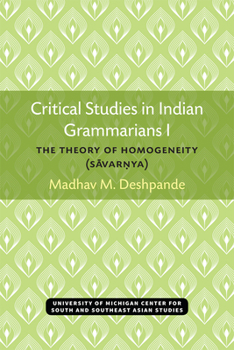Critical Studies in Indian Grammarians I: The Theory of Homogeneity (Savar?ya)
In the historical study of the Indian grammarian tradition, a line of demarcation can often be drawn between the conformity of a system with the well-known grammar of Pāṇini and the explanatory effectiveness of that system. One element of Pāṇini's grammar that scholars have sometimes struggled to bring across this line of demarcation is the theory of homogeneity, or sāvarṇya, which concerns the final consonants in Pāṇini's reference catalog, as well as phonetic similarities between sounds. While modern Sanskrit scholars understand how to interpret and apply Pāṇini's homogeneity, they still find it necessary to unravel the history of varying interpretations of the theory in subsequent grammars. Madhav Deshpande's The Theory of Homogeneity provides a thorough account of the historical development of the theory. Proceeding first to study this conception in the Pāṇinian tradition, Deshpande then passes on to other grammatical systems. Deshpande gives attention not only to the definitions of homogeneity in these systems but also the implementation of the theory in those respective systems. Even where definitions are identical, the concept may be applied quite differently, in which cases Deshpande examines by considering the historical relationships among the various systems.
Format:Paperback
Language:English
ISBN:0891480528
ISBN13:9780891480525
Release Date:January 1975
Publisher:U of M Center for South Asian Studies
Length:236 Pages
Weight:0.79 lbs.
Dimensions:0.6" x 6.0" x 9.0"
Customer Reviews
0 rating





